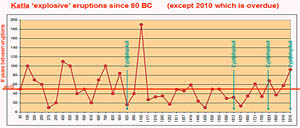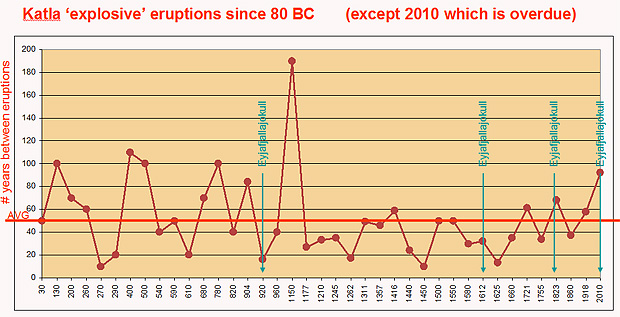Katla Eruption History

The average time between Katla eruptions since 80 BC is 52 years. The Icelandic volcano has pretty much followed this average time between eruptions except for a few instances, one of which extended 190 years leading to the eruption of 1150. However there is some controversy regarding an eruption in the year 1000 (which would have followed the ongoing average) in that the tephra / ash of that time was credited to a different volcano.
Two simple statistical observations why Katla could be ready to erupt once again…
- 92 years have ticked by since Katla’s last explosive eruption, nearly twice the average 52 years between historical eruptions. We are overdue in 2010.
- Eyjafjallajokull, Katla’s nearest neighbor volcano has erupted four times, while each eruption has occurred immediately preceding a Katla eruption. As you can see in the time-line above, it seems more than just coincidence that these two volcanoes have erupted together during the past 2,000 years.
Now that Eyjafjallajokull has erupted (14-Apr-2010), the clock is set and ticking for Katla (assuming history repeats itself). The Katla volcano, which hides beneath the Myrdalsjökull icecap, has the potential explosive power of perhaps up to ten times that of Eyjafjallajokull, and is currently awake with regular earthquakes popping underneath it.
There are additional and more scientific ways to predict the eruption (monitoring tremors and frequencies, earthquake swarms, GPS movements, expansion – contraction, etc..) however in this example, I thought I would simply look at history, knowing that it truly does often repeat itself.
So, why is any of this important? The Katla variety volcano is large enough to cause significant disruption in today’s modern society which depends on unobstructed air travel, and whose population lives on food that is grown on highly leveraged super-farms that in turn depend upon nature to provide adequate sunlight, weather, and temperatures to maintain their output. If Katla’s ash plume is large enough and explodes high enough, it could potentially cause great local damage while lowering global temperatures and blocking some percentage of sunlight from reaching the ground for a period of time. Are you prepared?
If you enjoyed this post, or topics of preparedness, consider subscribing to our survival blog RSS feed or Email notification of new posts on the Modern Survival Blog

